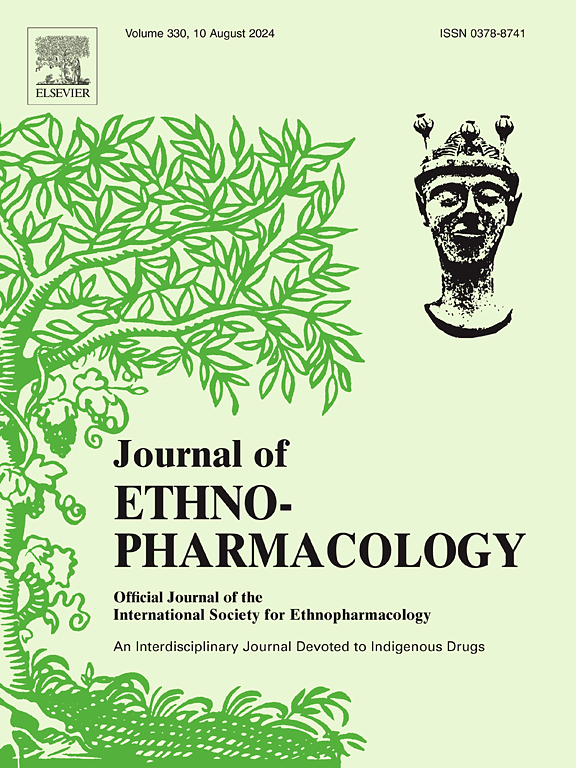Exploring the pharmacological mechanism of Bu-Wang San on Alzheimer's disease through multiple GEO datasets of the human hippocampus, network pharmacology, and metabolomics based on GC-MS and UPLC-Q/TOF-MS
IF 4.8
2区 医学
Q1 CHEMISTRY, MEDICINAL
引用次数: 0
Abstract
Ethnopharmacological relevance
Bu-Wang San (BWS) is a prominent traditional Chinese medicine known for calming the mind and promoting intelligence. It has been reported to improve learning and memory, enhance memory ability, and promote synaptic plasticity. However, the complexity of the material basis and the diversity of therapeutic targets of BWS on Alzheimer's disease (AD) have not been elucidated.
Aim of the study
This study aimed to investigate the therapeutic material basis and the mechanism of BWS in AD treatment by comprehensively analyzing multiple GEO datasets of the human hippocampus, network pharmacology, and multi-platform metabolomics validation.
Materials and methods
Three GEO datasets of the human hippocampus were utilized to identify AD-associated targets using weighted gene co-expression network analysis (WGCNA) and differential analysis. Network pharmacology analyses were performed to investigate BWS's therapeutic material basis and predict the therapeutic targets of BWS on AD. A rat model was induced through the concurrent administration of AlCl3 and D-galactose to validate BWS's therapeutic potential and underlying mechanisms in AD. To validate the results of GEO data mining and network pharmacology, a comprehensive metabolomics approach integrating gas chromatography-mass spectrometry (GC-MS) and ultra-performance liquid chromatography-quadrupole time-of-flight mass spectrometry (UPLC-QTOF/MS) was conducted on rat serum samples to uncover potential metabolic alterations and their associated pathways.
Results
A total of 6367 genes were selected as AD drug targets through WGCNA analysis and enrichment analysis of disease-associated gene expression profiles in the GEO database. Network pharmacology was performed in this study for the identification of potential interactions between the components of BWS and its targets, TP53, STAT3, EGFR, MAOA, NOS3, PPARG, PRKCA, MAPK8, AChE, ARG1, among others, which were among the top 25 highest probable targets of BWS acting on AD. The multi-platform metabolomics indicated that amino sugar and nucleotide sugar metabolism, glycine, serine and threonine metabolism pathways, and other pathways may be associated with the AD model based on AlCl3 and D-galactose. The comparison of differential metabolites between the AD model group and the BWS intervention group revealed that 66 of the 97 differential metabolites exhibited a pullback trend, indicating a potential therapeutic effect of BWS on these metabolites.
Conclusion
This study builds a systematic strategy combining GEO datasets, network pharmacology, and multi-platform metabolomics and provides valuable insights into the pharmacological mechanism of BWS on AD. The results suggest that BWS may exert its therapeutic effects on AD by modulating the amino sugar and nucleotide sugar metabolism, glycerophospholipid metabolism, glycine, serine and threonine metabolism pathway and acting on the drug targets of ARG1, MAOA, AChE, XDH, GAD2 et al. This strategy provides a deep understanding of the molecular mechanisms of herbal medicine in treating AD at a systematic level.
基于GC-MS和UPLC-Q/TOF-MS的人体海马GEO多数据集、网络药理学和代谢组学,探索补王散治疗阿尔茨海默病的药理机制。
民族药理学相关性:补王散(BWS)是一种著名的传统中药,以镇静心灵和提高智力而闻名。据报道,它可以改善学习和记忆,增强记忆能力,促进突触可塑性。然而,BWS治疗阿尔茨海默病(AD)的物质基础的复杂性和治疗靶点的多样性尚未阐明。研究目的:本研究旨在通过综合分析人海马GEO多数据集、网络药理学、多平台代谢组学验证,探讨BWS治疗AD的治疗物质基础及机制。材料和方法:利用人类海马的三个GEO数据集,利用加权基因共表达网络分析(WGCNA)和差异分析识别ad相关靶点。通过网络药理学分析,探讨BWS治疗AD的物质基础,预测BWS对AD的治疗靶点。通过同时给药AlCl3和d -半乳糖诱导大鼠模型,验证BWS对AD的治疗潜力和潜在机制。为了验证GEO数据挖掘和网络药理学的结果,对大鼠血清样本进行了综合代谢组学方法,结合气相色谱-质谱(GC-MS)和超高效液相色谱-四极杆飞行时间质谱(UPLC-QTOF/MS),以揭示潜在的代谢改变及其相关途径。结果:通过WGCNA分析和GEO数据库疾病相关基因表达谱富集分析,共筛选出6367个基因作为AD药物靶点。本研究通过网络药理学方法鉴定了BWS成分与其靶点TP53、STAT3、EGFR、MAOA、NOS3、PPARG、PRKCA、MAPK8、AChE、ARG1等之间的潜在相互作用,这些靶点是BWS作用于AD最有可能的前25个靶点。多平台代谢组学分析表明,基于AlCl3和d -半乳糖的AD模型可能与氨基糖和核苷酸糖代谢、甘氨酸、丝氨酸和苏氨酸代谢途径等相关。对比AD模型组和BWS干预组的差异代谢物,97种差异代谢物中有66种呈回调趋势,说明BWS对这些代谢物有潜在的治疗作用。结论:本研究构建了GEO数据集、网络药理学和多平台代谢组学相结合的系统策略,为BWS治疗AD的药理机制提供了有价值的见解。结果提示,BWS可能通过调节氨基糖和核苷酸糖代谢、甘油磷脂代谢、甘氨酸、丝氨酸和苏氨酸代谢途径,作用于ARG1、MAOA、AChE、XDH、GAD2等药物靶点,发挥其治疗AD的作用。这一策略提供了对草药在系统水平上治疗AD的分子机制的深刻理解。
本文章由计算机程序翻译,如有差异,请以英文原文为准。
求助全文
约1分钟内获得全文
求助全文
来源期刊

Journal of ethnopharmacology
医学-全科医学与补充医学
CiteScore
10.30
自引率
5.60%
发文量
967
审稿时长
77 days
期刊介绍:
The Journal of Ethnopharmacology is dedicated to the exchange of information and understandings about people''s use of plants, fungi, animals, microorganisms and minerals and their biological and pharmacological effects based on the principles established through international conventions. Early people confronted with illness and disease, discovered a wealth of useful therapeutic agents in the plant and animal kingdoms. The empirical knowledge of these medicinal substances and their toxic potential was passed on by oral tradition and sometimes recorded in herbals and other texts on materia medica. Many valuable drugs of today (e.g., atropine, ephedrine, tubocurarine, digoxin, reserpine) came into use through the study of indigenous remedies. Chemists continue to use plant-derived drugs (e.g., morphine, taxol, physostigmine, quinidine, emetine) as prototypes in their attempts to develop more effective and less toxic medicinals.
 求助内容:
求助内容: 应助结果提醒方式:
应助结果提醒方式:


